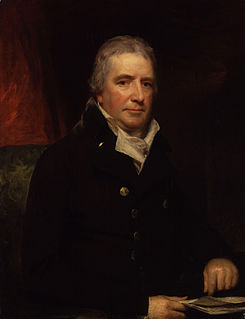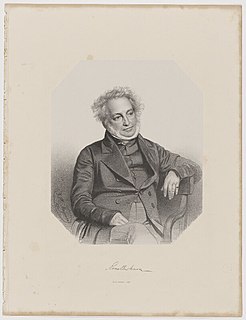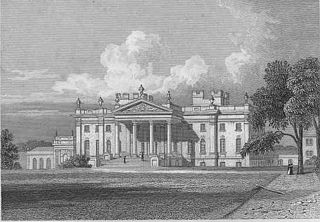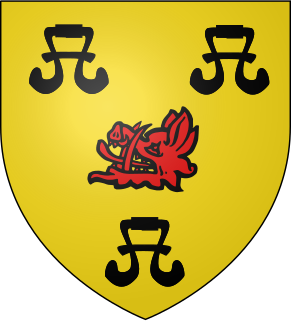
George Rose was a British politician.

Field Marshal Hugh Henry Rose,1st Baron Strathnairn,was a senior British Army officer. He served as a military adviser to the Ottoman Army who were seeking to secure the expulsion of the forces of Mehemet Ali from Syria during the Egyptian–Ottoman War. He then fought with the French Army at the Battle of Alma,the Battle of Inkerman and at the Battle of Mamelon during the Crimean War. During the Indian Rebellion of 1857 Rose was given command of the Central Indian Field Force and was successful at the battle of Jhansi in April 1858,at Lahore in May 1858 and at Gwalior in June 1858. He went on to be Commander of the Bombay Army,Commander-in-Chief,India and then Commander-in-Chief,Ireland.

Leiston Abbey outside the town of Leiston,Suffolk,England,was a religious house of Canons Regular following the Premonstratensian rule,dedicated to St Mary. Founded in c. 1183 by Ranulf de Glanville,Chief Justiciar to King Henry II (1180-1189),it was originally built on a marshland isle near the sea,and was called "St Mary de Insula". Around 1363 the abbey suffered so much from flooding that a new site was chosen and it was rebuilt further inland for its patron,Robert de Ufford,1st Earl of Suffolk (1298-1369). However,there was a great fire in c. 1379 and further rebuilding was necessary.

Aldringham is a village in the Blything Hundred of Suffolk,England. The village is located 1 mile south of Leiston and 3 miles northwest of Aldeburgh close to the North Sea coast. The parish includes the coastal village of Thorpeness. The mid-2005 population estimate for Aldringham cum Thorpe parish was 730.

Clan Rose is a Scottish clan of the Scottish Highlands.

Sir Clement Higham,or Heigham,of Barrow,Suffolk,was an English lawyer and politician,a Speaker of the House of Commons in 1554,and Chief Baron of the Exchequer in 1558–1559. A loyal Roman Catholic,he held various offices and commissions under Queen Mary,and was knighted in 1555 by King Philip,but withdrew from politics after the succession of Queen Elizabeth I in 1558.
Sir George Henry Rose GCH was a British politician and diplomat.

Clan Calder is a Highland Scottish clan. The clan is recognised by the Lord Lyon King of Arms but as it does not currently have a clan chief it is therefore considered an armigerous clan.

Sir John George Shaw Lefevre KCB was a British barrister,Whig politician and civil servant.

Frederick William Brook Thellusson,5th Baron Rendlesham,was a British Conservative politician.

Madeley Old Manor,was a medieval fortified manor house in the parish of Madeley,Staffordshire. It is now a ruin,with only fragments of its walls remaining. The remnants have Grade II listed building status and the site is a Scheduled Ancient Monument. The Tudor manor house is illustrated by Michael Burghers as it appeared in 1686 in Plot's History of Staffordshire,together with the formal gardens and a later east frontage. It is situated a short distance to the south of Heighley Castle,a mediaeval seat of the Audley family.

Frederick Thellusson,4th Baron Rendlesham,was a British Conservative Party politician.

Henry John Fanshawe Badeley,1st Baron Badeley,KCB,CBE,known as Sir Henry Badeley between 1935 and 1949,was a British civil servant and engraver. He was Clerk of the Parliaments from 1934 to 1949.

Sir William Brampton Gurdon was a British civil servant who became a Liberal Party politician.

Thomas Duncombe was a British politician who sat in the House of Commons between 1751 and 1779.

Ipswich Greyfriars was a mediaeval monastic house of Friars Minor (Franciscans) founded during the 13th century in Ipswich,Suffolk. It was said conventionally to have been founded by Sir Robert Tibetot of Nettlestead,Suffolk,but the foundation is accepted to be set back before 1236. This makes it the earliest house of mendicant friars in Suffolk,and established no more than ten years after the death of St Francis himself. It was within the Cambridge Custody. It remained active until dissolved in the late 1530s.
Sir Henry John Lowndes Graham was a Scottish public servant,Clerk of the Parliaments from 1885 to 1917.
The Barony of Muirton is a Scottish feudal barony near Forres along the Findhorn River in Moray.

Baron of Kilravock is a Feudal Barony in the Peerage of Scotland. It was created in 1293 by John Balliol for Hugh Rose of Geddes. The holders of the title Baron of Kilravock have also held the Chiefdom of Clan Rose.
















